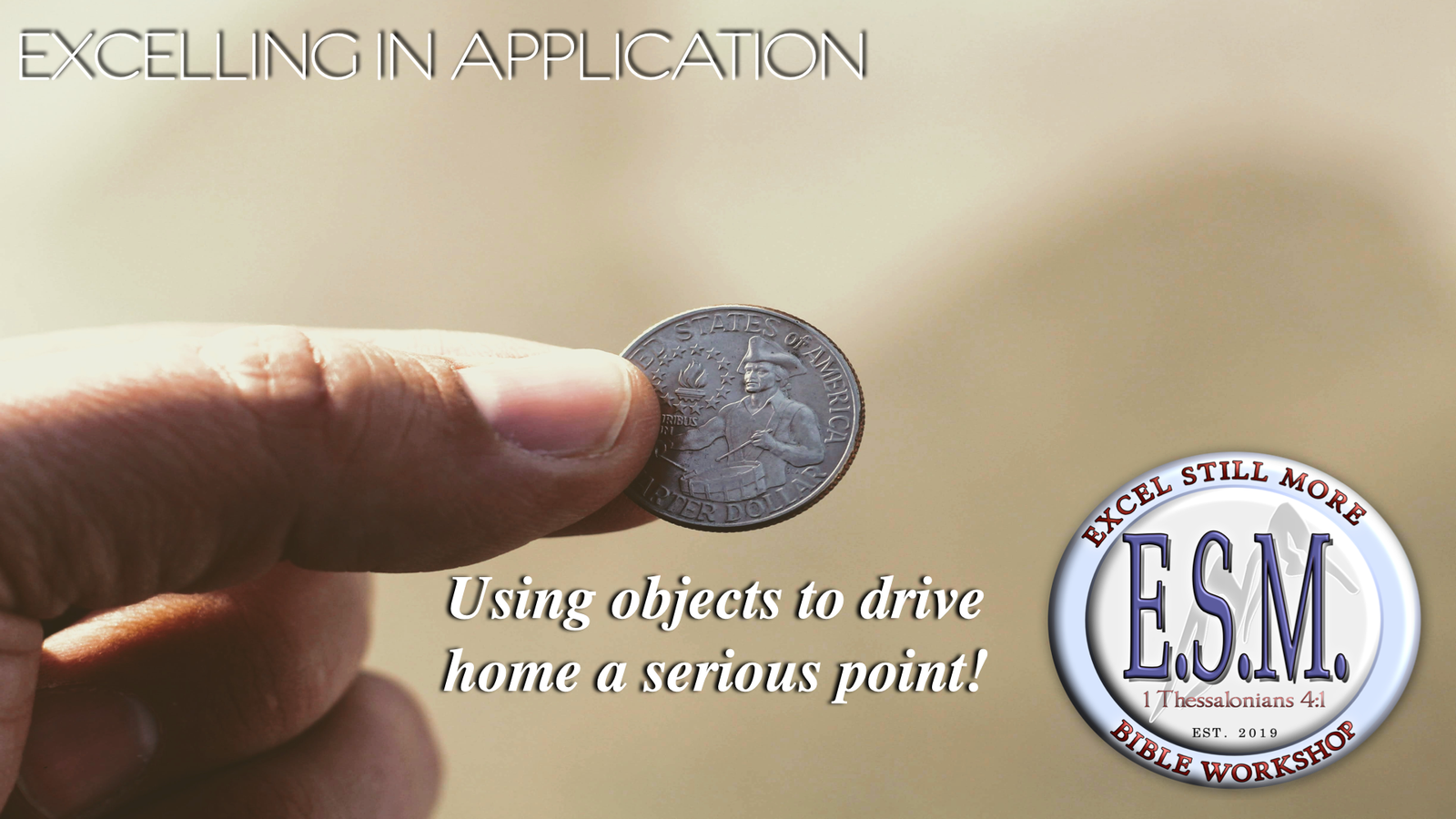“Tell us then, what do You think? Is it lawful to give a poll-tax to Caesar, or not?” But Jesus perceived their malice, and said, “Why are you testing Me, you hypocrites? Show Me the coin used for the poll-tax.” And they brought Him a denarius. And He said to them, “Whose likeness and inscription is this?” They said to Him, “Caesar’s.” Then He said to them, “Then render to Caesar the things that are Caesar’s; and to God the things that are God’s.”...Matthew 22:17-21
Using objects to drive home a serious point can be an effective tool in making the application. An extraordinarily long rope that represents time, an eraser that draws us into the concept of forgiveness, a sponge that effectively demonstrates the absorption of our surroundings, and even a coin, as Jesus used in Matthew 22, can be used to show the difference between the physical and the spiritual. When used appropriately, there’s no doubt that an application effectively made using an object can be highly beneficial to your audience. However, how does one use an object effectively when making the application? Here are some pointers that may help next time you try this.
Tip #1: Think Through the Use of the Object Before Using It
I know this sounds elementary; however, sometimes, the use of the object in making the application can be one of those “last-minute” or “I’ll figure it out when I get there” sorts of things. While being flexible in the lesson and comfortable enough with your content that you can improvise when necessary is a blessing, it can fall apart quickly when it comes to using an object illustration. Spend time in the lesson prep determining when you’ll introduce the object, at what point you reveal the spiritual application, and how you will transition once the illustration is made. Remember, preaching and teaching are more than simply giving information; and it’s also about effectively delivering the content.
Tip #2: Make the Object Illustration Easy to Understand
The average person you will be speaking to is not prepared to receive a college-level lecture when they come to your class or worship. It’s not that they aren’t ready to learn; however, as a preacher/teacher, you have studied much more deeply and for hours to deliver a lesson. The students/worship attendees have not spent that time, nor are they mentally prepared to parse the Greek words as you have. So, your lesson needs to be profound yet simple enough that even a child understands what you’re teaching. The same applies when using an object illustration to make an application. Make sure your object illustration and how you deliver it are simple enough that the youngest can understand.
Tip #3: Don’t Make the Entire Application Dependent on the Object Illustration
You’ve thought it through and spent time studying, and now you’re ready to deliver the lesson. While I would love to tell you that there will be no hick-ups or mishaps in your lesson, I can’t. The truth is microphones cut out, projectors glitch, PowerPoint presentations reformat, and object illustrations sometimes don’t work. As a preacher/teacher, you must adapt on the fly and continue with the lesson. That’s why the object illustration you’ve chosen must not be the center of your study. Please keep it in its proper place. The object illustration is only there to serve as another window to see into the more profound, spiritual point. If the example fails or misses, the lesson can still succeed as long as the object illustration is kept in place.
Tip #4: Don’t Plan Your Lesson Around the Object Illustration
I know it’s tempting. You have this superb object illustration that comes to your mind throughout the week, so you want to use it. You begin thinking about the point of the illustration, and then you go to the Scriptures to find passages that will support your point. Let me first say that is the absolute wrong way to approach sermon/lesson prep. God’s Word should always be the driving force of the lesson, not our illustrations. The illustration is there to help make the application of the lesson revealed through the text. God is always glorified when we keep that in mind, and those in the class/worship service will be blessed.
I’ll never forget when I used a flashlight as an object illustration to drive home the main point of a lesson. At the right time, I thought I would take the battery out of the flashlight and then turn it on, and the light would fail to come on. Then, I would replace the battery and turn it on. This time, the light would come on, and the point could be made – when connected to the power source, we shine brighter than we do when we aren’t connected. It would have been amazing if it had only worked as planned, but that’s not what happened. The first part went great; however, the light never came on once I replaced the battery and clicked the button. It’s hard to say the light shines bright when connected to the power source when the light doesn’t come on.
If this hasn’t happened to you yet, it will at some point. That’s just the nature of using object illustrations; however, that doesn’t mean we should never use them. When used effectively, object illustrations can help serve as an anchor that holds the spiritual point of the message in the mind of the listener. That’s just it, be intentional and purposeful with them. You’ll be glad you did, and so will those who are listening.





